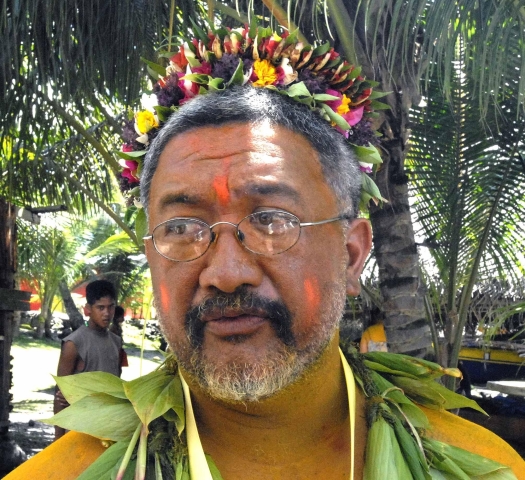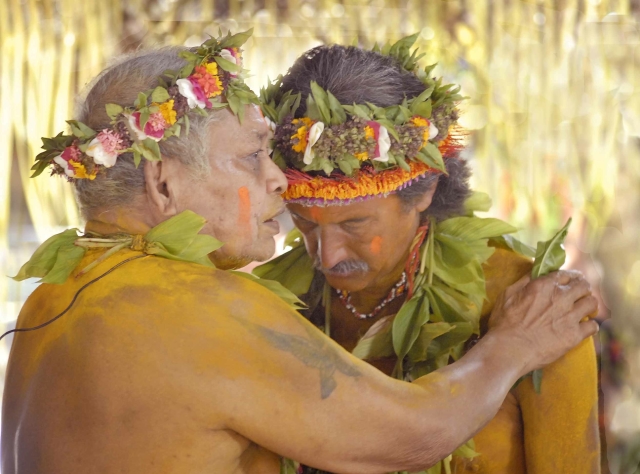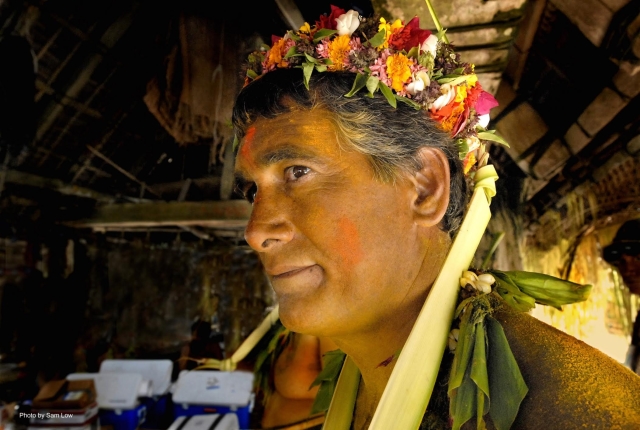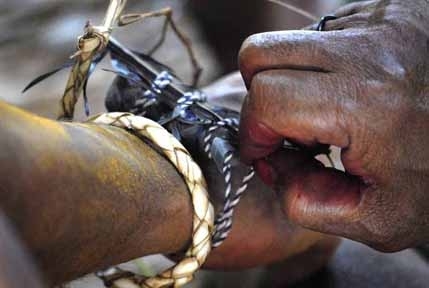
Hōkūleʻa Mo‘olelo: The Pwo Ceremony
- Posted on 17 Mar 2017
- In Crew Blogs, Hōkūleʻa History & Moʻolelo
 Exactly ten years ago, on March 17th, 2007, Pius Mau Piailug held a ceremony to initiate 16 of his students as Pwo – Master Navigators – and realized one of the most important goals in his long and illustrious life – the perpetuation of the ancient art of wayfinding passed down to him by his ancestors.
Exactly ten years ago, on March 17th, 2007, Pius Mau Piailug held a ceremony to initiate 16 of his students as Pwo – Master Navigators – and realized one of the most important goals in his long and illustrious life – the perpetuation of the ancient art of wayfinding passed down to him by his ancestors.
We celebrate that moment with this description of it by Hōkūle‘a crewmember and documenter, Sam Low, who was privileged to attend the ceremony on Mau’s home island of Satawal.
The island was tiny. As we sailed around its southern shore, the aroma of land reached us. We saw a line of lofty canoe houses and a crowd on the beach. Their singing – soft, undulating – blended with the wind.
It was March 15th, 2007 and I was aboard Hōkūle‘a as we made landfall on Satawal, Mau Piailug’s home island. This voyage began fifty-one days ago when Hōkūle‘a set off from Hawai‘i, accompanied by another voyaging canoe – Alingano Maisu – a similar double-hulled vessel that had been built as a gift for Mau.
A conch shell was blown on the island and small boats came out to assist with placing our anchors. The sun, low on the horizon, glowed in surf breaking on the reef. We had finally arrived at the place where the revival of the ancient art of navigation, led by Mau, had begun.
*****
Mau sailed aboard Hōkūle‘a on her first two successful voyages from Hawaii to Tahiti. From 1985 to 1987, he voyaged on various legs of her next mission – a two year, 16,000 mile retracing of almost all the traditional voyaging routes – that inspired a revival of seafaring culture throughout Polynesia.
Hōkūle‘a’s voyages stimulated others to build large traditional canoes. In 1992, Hekenukumai Busby, a New Zealand Maori elder, constructed Te Aurere, a large voyaging canoe of his own. In 1993, Hawai’iloa was launched on O‘ahu with support from the Polynesian Voyaging Society and in 1995, Shorty Bertelmann and his brother Clay launched yet another canoe, Makali‘i, on the Big Island of Hawai‘i. In that same period, Tahiti Nui was built on the island of Tahiti and Takitumu and Te ‘Au o Tonga were built on Rarotonga. In 1995, all of these canoes set off from the Marquesan Island of Nuku Hiva bound for Hawai‘i, the first time in a thousand years that a fleet of Polynesian sailing canoes had journeyed together. All arrived safely and made their way back to their home islands again, guided by navigators trained by Mau Piailug with the assistance of Nainoa Thompson.
All these voyages, and Mau’s mentorship of native Polynesian navigators, stimulated not only the building and sailing of canoes, but the revival of Polynesian culture in general. Among Hawaiians, where the loss of culture had been particularly severe, hālau hula (hula schools) seemed to spring up everywhere, heiau were rebuilt, ancient curing practices were revived and, in 1999, the first class of high school students graduated having spoken only Hawaiian from their entry into the first grade. Reinvigorated Hawaiians stood up to demand the return of lands taken from them illegally. In 1995, President Clinton signed the Apology Decree – validating their claims – and today, many Hawaiians are working to regain their sovereignty as a native people.
In 1999, Mau carried out the most significant step in his plan to revive his own traditions by sailing aboard the Hawaiian canoe, Makali‘i, to his home waters, making landfall on many of the major islands in the Federated Sates of Micronesia. In 2001, Mau returned to Hawai‘i to begin building Alingano Maisu – a gift to him from Shorty and Clay Bertelmann and many others for all that he had done for Hawaiians.
Now, in 2007, as Hōkūle‘a and Maisu anchored off Satawal, Mau was 75 years old and suffering from a life-threatening kidney ailment. It was time, he thought, to bring together his entire voyaging family for an ancient initiation ceremony – pwo – that was last performed on Satawal fifty-six years ago.
Eleven men from Satawal had studied sufficiently to earn the privilege of being initiated as pwo navigators; Selestine Retewailam, Andrew Igomal, Isidore Metewalur, Romanes Yarofaichiy, Lorenzo Sartilug, Manno Ratilou, Alfonso Reilug, Luke Yauritik, Camilo Eraegmai, John Lalogo and Mau’s son, Sesario Sewralur. In addition, five men from Hawai‘i would be initiated – Nainoa Thompson, Shorty Bertelmann, Chad Paishon, Chad Baybayan and Bruce Blankenfeld.
******
On the day of the pwo ceremony, March 17th, outrigger canoes were drawn up on Satawal’s sheltered shore beneath lofty canoe houses, their thatch roofs glistening in the sun and their floors covered with fresh woven mats.
The ceremony began early in the morning when men arrived with firewood – led by one of the island’s initiated navigators. They laid the wood in a small grove of coconut palms where other men prepared breadfruit for baking. The village was filled with song from women working about a hundred yards away, preparing taro.
The men dug an earth oven and kindled the sacred firewood. The initiated navigator placed two kinds of coral in the fire to convey sacred powers. Hard coral signified the mental and physical toughness of the navigator and stinging coral symbolized the strength of the navigator’s command at sea.
Joining Mau for the ceremony was an initiated navigator from the nearby island of Pulap, Lambert Lokopwe. “They wait until the fire is red hot,” Lambert explained, “Then they put the coral on top of the fire. When the breadfruit is cooked, the men start pounding it. The women are pounding sweet taro. When both are complete, the women put it in the uulong – a special calabash. Then they cover it up and see that the uulong faces the Big Bird – raising Mailap, east – and it stays overnight for the final ceremony the next day.“
During the early morning on Sunday, the day of the pwo ceremony, the wind died and shifted easterly, casting the anchorage in a lee. The ocean was deep blue offshore and emerald in the tiny lagoon. The sixteen navigators, powdered with yellow turmeric, dressed in red loin cloths and garlanded with headbands of colorful flowers sat patiently in the canoe house. Around their necks was a lei of ginger leaves – yoangerhik – a medicinal plant.
The women gathered outside and sang rhythmically. At about ten AM, Mau was helped to a white plastic seat cushioned by blankets and woven mats. One by one, the men crawled to him and he rubbed them with a sacred medicine, first on the forehead, then on the heart, chanting as he blessed each pwo navigator. “The medicines are given to the heart and to the mind for the navigator to have seram – light,” Lambert says, “so he voyages with the light, never darkness.”
Next, Mau touched each navigator on the shoulder with a long strand of coconut fiber which he then parted and placed over their heads as a garland. Mau’s face was somber, reflecting the power of this blessing. The incoming navigators were then given a special coconut to drink – nuun-lesseram or “coconut in the light.” “The coconut will give light to the new navigator,” Lambert said, “but the deeper meaning is perseverance, confidence in yourself as a new master navigator. That coconut is a large one. Each navigator drinks it and never stops until it is completely gone, meaning that he has full confidence in himself – that he will pursue the course until it is finished.”
The sacred calabash – the uulong – was then covered with woven mats. Two gods – Luukeileng, the center of heaven, the god that controls everything; and Weriyeng, the god of navigation, owned the calabash. During the final rites, Mau instructed each incoming pwo, one by one, to place their right hand on the covered uulong while he prayed to the two gods to bestow pwo upon him.
Each new pwo was then given a bracelet that contained the stinging coral representing the power of the navigator’s words and the hard coral conveying his toughness in the face of adversity. Tied to the bundle were feathers of the Big Bird. “Mau is calling upon Luukeileng and Weriyeng to bestow all rights, everything concerning navigation, on this person,” Lambert explained. Finally, the food from the sacred calabash was divided and eaten by all the initiated navigators.
A year later, in March of 2008, Mau presided over one last pwo ceremony for Maori navigator Hekenukumai Busby, the builder of Te Aurere. On July 12, 2010, Mau passed away on Satawal.
All his life, Mau had struggled to spread the knowledge he inherited from his ancestors. Almost single-handedly he reversed two centuries of cultural decline among Hawaiians, replacing it with a resurgent pride in their great seafaring heritage. Today, Alingano Maisu sails among the Caroline Islands, captained by his son, Sesario Sewralur, to carry on Mau’s mission of reviving his own seafaring culture. And throughout the vast Pacific, canoes are being built and sailed by a revived nation of seafarers. The seram – the powerful light – that Mau Piailug first carried to Hawai‘i in 1973, will forever inspire the people of the Pacific and beyond to raise islands from the sea.
The above moʻolelo was adapted by Hōkūleʻa crewmember and documenter Sam Low from his book – Hawaiki Rising, Hokule’a, Nainoa Thompson and the Hawaiian Renaissance.











